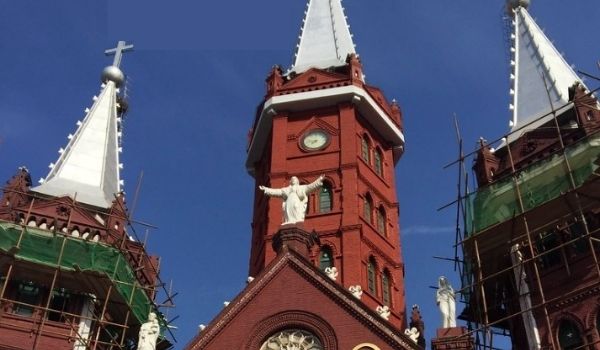
Tangshan diocese covers six districts, two county-level cities and six counties. They are Lubei, Lunan, Guye, Kaiping, Fengrun and Fengnan districts, Zunhua and Qian'an cities, and Luan, Luannan, Laoting, Qianxi, Yutian and Tanghai counties.
Tangshan has a history of more than one hundred years. Its name derives from Dachengshan Mountain in the urban city. The city suffered an earthquake of magnitude 8.2 (7.8 from official report) at 3:42 a.m. on July 28, 1976, which resulted in many casualties. The official death toll was 255,000, but many experts believe the actual number of fatalities was two to three times that number, making it the most destructive earthquake in modern history. As a result of the earthquake, most of the town had to be rebuilt.
As of 2010, Tangshan has a registered population of 7.57 millions, an increase of 238,000 people from the year before. Non-farming population is slightly higher than the farming population also by around 230,000 people.
Mandarin and Tangshan dialect are in use in the diocesan territory.
In 1899, the Apostolic Vicariate of eastern Chi-li was detached from the Apostolic Vicariate of northern Chi-li. It was renamed into Yongping in 1924. It was elevated to Yongping diocese in 1946. After the revival of religious activities in 1980, Yongping diocese was renamed as Tangshan, where the bishop's house was located. However, the underground community continues to refer to the diocese as Yongping. Photo on top: Immaculate Conception Cathedral of Tangshan diocese. Built in 1989, the church can accommodate 2,000 people and its bell towers are 53 meters tall
There are the Sannuhe Airport and the Tangshan New Train Station in Tangshan. With the expressway, it takes only one hour from Tangshan to reach Beijing, Tianjin or to the closest edge of northeastern China. For sea transport, Tangshan has Tangjing, Caofeidian and Fengnan ports. Caofeidian port is also expected to being turned into a tourist spot with the building of a cruise port. The city has also planned to build light railroad and underground metro systems for its 12th five-year plan.
Tangshan has a humid continental climate, cold but dry winters, and hot, humid summers. In January, temperatures in the daytime often remain below freezing, and in July, consistently rise above 30 ?C (86 ?F), sometimes to 35 ?C (95 ?F). Well over half of the annual precipitation falls in July and August alone.
Tangshan is an important city with heavy industry in northern China. Its outputs include machinery, motor vehicles, chemicals, textiles, glass, petroleum products and cement. It has been a coal-mining center since late Qing dynasty, as Guangdong merchant Tong King-sing opened the first coal mine using modern techniques in Kaiping in 1877. Since the construction of the Caofeidian Project (a sea reclamation project to construct the Caofeidian Industrial Zone), it has hosted large iron and steel plants, chemical projects, and electricity plants. Historically, modern industry in China first arose in Tangshan. The first railway in China was built from Xugezhuang to Tangshan in 1877 and the first fire-resistant material manufactory, and the first and largest cement manufactory were constructed in Tangshan as well.
Tangshan is located in the central section of the circum-Bohai Sea region, facing the Bohai Sea to the south. Lying on the North China Plain, Tangshan is adjacent to the Yanshan Mountains to the north, borders the Luan River and Qinhuangdao to the east, and to the west adjoins with Beijing and Tianjin. Because of its location in the northeast of Hebei, it is a strategic area and a corridor linking Northern China and Northeastern China.
Tangshan No. 1 Middle School (founded 1902) is one of the most famous high schools in China. Several universities also find their homes in Tangshan, such as Hebei United University, Tangshan Normal College, and Light Industrial College of Hebei Polytechnic University.
Tangshan is famous for its Ping Opera, which appears around 1909. It is the second largest opera genre following Beijing Opera. One will also find it interesting to watch Tangshan Shadown Play and to hear the Laoting Drums. These three cultural items were called "Three Flowers of Jidong (eastern Hebei)."